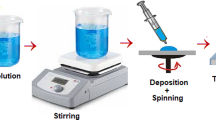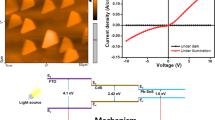Abstract
Digital x-ray detectors consist of a conversion material, which converts incident radiation to an electrical signal, as well as a read-out circuit that is used to detect the electrical signal. Research is being conducted in order to improve their performance across various fields. In particular, many studies have explored the conversion materials to address the limitations of amorphous selenium (a-Se) currently in use and to develop alternative materials. Mercuric iodide (HgI2) is one of the alternative materials being considered as it has greater x-ray sensitivity than a-Se and other candidate materials. This is due to its high atomic number and high x-ray absorption efficiency. It also had a high rate of electron-hole pair generation per particle due to its low pair creation energy. However, it is difficult to commercialize HgI2 due to its high leakage current and unstable x-ray sensitivity. This study aims to resolve the disadvantages of HgI2 by adding silicone dioxide (SiO2), which is used as oxide film and insulating film in semiconductor processes, and titanium dioxide (TiO2), which is used as an electrode in dye sensitizer solar cells. Detectors are fabricated for analysis using HgI2, HgI2-TiO2, and HgI2-SiO2 unit-cells and the particle-in-binder method. SEM, dark current, and x-ray sensitivity measurements are used to compare their structural characteristics, electrical properties, and stability, respectively.
Similar content being viewed by others
References
H. Du et al., Phys. Med. Biol. 53, 1325 (2008).
A. R. Cowen, A. G. Davies and M. U. Sivananthan, Clin. Radiol. 63, 1073 (2008).
M. J. Yaffe and J. A. Rowlands, Phys. Med. Biol. 42, 1 (1997).
K. W. Shin, Ph.D. thesis, Waterloo University, 2014.
K. Oh et al., J. Inst. 7, 3 (2012).
S. O. Kasap and J. A. Rowlands, IEEE 90, 591 (2002).
S. Tokuda et al., Proc. SPIE. Int. Soc. Opt. Eng. 4320, 140 (2001).
M. Simon et al., IEEE. Tran. Nucl. Sci. 52, 2035 (2005).
G. Zentai et al., IEEE. Tran. Nucl. Sci. 53, 2506 (2006).
S. O. Kasap et al., J. Sen. 11, 5112 (2011).
M. B. Nelson, Ph.D. thesis, Air Force Institute of Technology, Air University, 2003.
M. Ikeda, T. Oka, K. Mori and M. Atsuta, IEEE Nucl. Sci. Symp. Conf. Rec. 7, 4520 (2004).
H. Jiang et al., Phys. Med. Biol. 58, 7 (2013).
A. A. Zakharchenko et al., Characteristics of wide bandgap gamma-radiation detectors based on mercury compounds, Ukraine, July 2012.
M. M. Schieber et al., Proc. SPIE 3768, 296 (1999).
S. Music, N. F. Vincekovic and L. Sekovanic, Braz. J. Chem. Eng. 28, 89 (2011).
S. O. Kasap, M. Z. Kabir and J. A. Rowlands, Curr. Appl. Phys. 6, 288 (2006).
M. Z. Kabir and S. Kasap, Photoconductors for x-ray Image Detectors, Springer Handbook of Electronic and Photonic Materials, 1, (2017).
Y. J. Lee, J. H. Chae and M. Kang, J. Ind. Eng. Chem. 16, 609 (2010).
S. Muduli et al., Sol. Energy 86, 1428 (2012).
H. Klauk et al., J. Appl. Phys. 92, 5259 (2002).
Acknowledgments
This work was supported by the Creative Allied Project (CAP-15-06-ETRI) of the National Research Council of Science & Technology.
Author information
Authors and Affiliations
Corresponding authors
Rights and permissions
About this article
Cite this article
Kim, KB., Kim, JS., Kim, KT. et al. Stabilization of Mercuric Iodide Using Titanium and Silicon Oxides. J. Korean Phys. Soc. 76, 484–489 (2020). https://doi.org/10.3938/jkps.76.484
Received:
Revised:
Accepted:
Published:
Issue Date:
DOI: https://doi.org/10.3938/jkps.76.484




